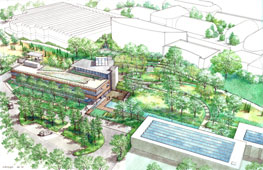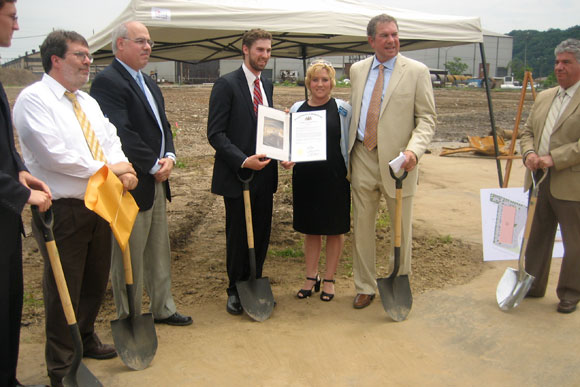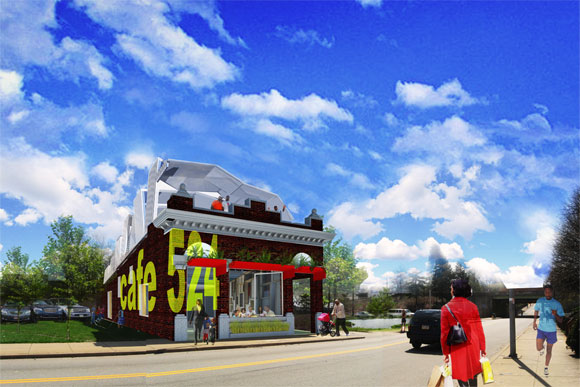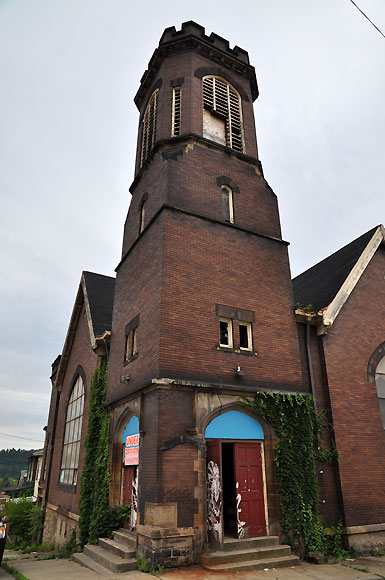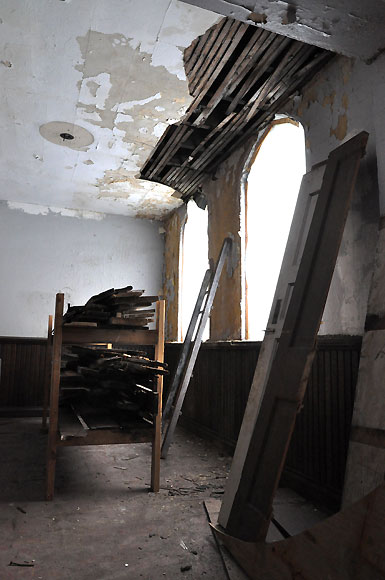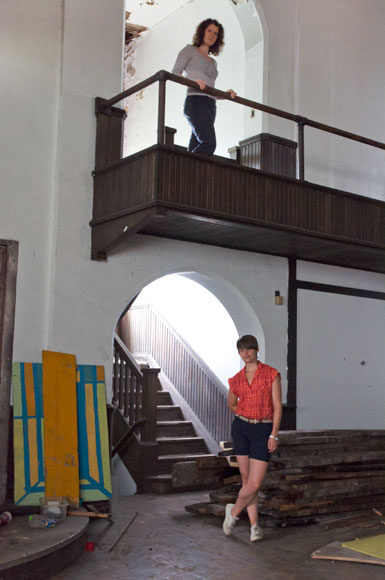
Category Archive: News Wire Services
-
Sewickley Tour Offers Glimpse at Early 1900s Garden
By Joanne Braun
SEWICKLEY HERALD
Thursday, June 17, 2010When Janice and Ronald West moved into their Sewickley Heights home 15 years ago, remnants of the past scattered the property.
One such remnant is an old cherub statue perched in the middle of The Gardens of Poplar Hill on the Country Club Road property. It will be included in the Sewickley Civic Garden Council’s garden tour Friday.

Sewickley Civic Garden Council's garden tour on Friday includes five private gardens within a few blocks of the Edgeworth Club, and a sixth, The Gardens of Poplar Hill in Sewickley Heights, adjacent to Allegheny Country Club. Carolyn Smith, garden tour event coordinator, checks out a few specimens at the Poplar Hill gardens. Joanne Braun | Sewickley Herald
The cherub, which sits in the lower garden, is surrounded by plants, shrubs, brick walls, black iron gates and a roofed summer house, all dating back to the early 1900s. The garden is being cataloged as a historic garden for the Smithsonian Institution in Washington. Village Garden Club’s Garden History and Design committee provided research and documentation — the first time the club, which is a member of the Garden Club of America, has attempted such an undertaking.
Committee members Cathy Snyder, Cordelia Jacobs, Alisa Lenhardt and Lisa Burrows will send their work to the club’s Garden Club of America’s zone coordinator in Philadelphia. Once the research and photos are approved, it will be sent to the Smithsonian for inclusion in the Archives of American Gardens.
Kelly Crawford, museum specialist at the Smithsonian, said the Archives of American Gardens collection captures more than 6,500 American gardens in 80,000 images, historic records, illustrations and plans.
“Some of these records fix a moment in the life of an existing garden, and others describe gardens that are no longer in existence,” she said.
Snyder said Arthur Shurcliff, a member of an architectural firm that became famous for its garden designs, designed the original landscaping at Poplar Hill in 1914.
The property once featured a 35-room carriage house, which later was torn down by a new owner. The property housed numerous families over the years who added structures, sold off some of the land and subdivided it.
In 1948, The Gardens of Poplar Hill were chosen as featured gardens at the Garden Club of America annual meeting. It was part of a tour sponsored by Pittsburgh History and Landmarks Foundation in 1997.
When the Wests moved in, they refurbished much of the deteriorating brickwork, rehung the iron gates, reconstructed and refurbished the limestone windows within the brickwork, and replaced the roof and copper gutters on the summer house.
At that time, most of the flower beds were empty. Poplar trees, for which the property was named, once grew outside the brick walls but were lost to disease in the 1960s.
“There were very little perennials left. We had to start over with the plantings,” Janice West said.
However, large specimen trees, bushes and hedges still flourished throughout the property, and peonies and Japanese iris remained in the lower garden.
As visitors enter the lower garden, they can walk on pathways of blue slate and pea gravel that wind around the inside courtyard. Niches with two Japanese statues, with shallow pools in front of each, face one another across the courtyard.
Also featured are blue spruce and juniper surrounding the side of the house. Dark green boxwood blends with the softer pastel hues of Russian sage and astilbe. Not far away are colored foxgloves and coneflowers mixing with japonica and peonies. Blue geraniums and Japanese grass also make a home in the garden.
“I try to repeat some of the same plants in different spots,” West said.
The couple purchased and placed stone urns to replicate those in photographs from the 1930s atop two brick pillars closer to the house.
Nearby are more large shrubs, which were not there in the original landscape.
“There used to be lillies and flowers along the way. This was just a walkway to the house. I thought about taking the bushes out, but they are so mature,” West said.
As visitors continue to the back of the house, they will get a view of the Allegheny Country Club’s fairways and clubhouse.
That side of the house features an added greenhouse and a large birdbath along with a horseshoe hedge of yews believed to be part of the original landscape. The Wests added more mature yews to the hedges to complete the horseshoe shape, which now surrounds the original English wellhead and two large swamp cypresses. Janice West planted a vegetable garden on the eastern side of the house in the rear, near to where other such gardens originally grew. Plants are held up by trellises of different colors.
In a document prepared for the Smithsonian, committee members wrote, “Without question, Poplar Hill remains a significant treasure in garden design. The fact that it is in the hands of genuine enthusiasts who understand and appreciate the importance of documenting its evolution, preserving its integrity and sharing its beauty with others bodes well for the future.”
If you go
What: Sewickley Civic Garden Council’s garden tour, including five private gardens within a few blocks of the Edgeworth Club. The sixth, The Gardens of Poplar Hill in Sewickley Heights, is adjacent to Allegheny Country Club.
When: 9 a.m. to 4 p.m. Friday. Jan Godshalk, award-winning floral designer, will present a floral arranging demonstration at a luncheon at the Edgeworth Club from noon to 1:30 p.m.
Cost: $20, or $35 for the demonstration. Lunch not included. A combination ticket for the tour and lecture is $50. Tickets are available in Sewickley at Cuttings, Walnut Street; The Gift Corner, Broad Street; and Penguin Book Store, Spoiled Chics and Cheers, Beaver Street.
For more information: Visit www.sewickleygardens.org.
-
Foundations Aid Pittsburgh YWCA’s Green Roof
By Bill Zlatos
PITTSBURGH TRIBUNE-REVIEW
Thursday, June 17, 2010The YWCA is getting a green roof, part of a campaign by charitable foundations to make Downtown more environmentally friendly.
“We’ve seen an increasing number of green roofs in Pittsburgh in the past three years, some of which are Downtown,” said Aurora Sharrard, director of innovation for the Pittsburgh Green Building Alliance.
When its roof is completed, the YWCA will join the Highmark Building, Fifth Avenue Place and the Heinz 57 Center among Downtown buildings with green roofs, she said. The Allegheny County Office Building also is installing one.
Green roofs use plants to soak up rain and reduce runoff, cut heating and air conditioning costs, make the building quieter and improve air quality.
Reducing runoff is especially important in Allegheny County because storm and sewage overflow is released into the rivers during hard rains.
“We want an environmentally responsible green roof,” said Carmelle Nickens Phillips, the YWCA’s vice president of development and communications. “It provides a lot of benefits — a longer material lifespan, energy savings, sound insulation, and it’s really compatible with the neighborhood.”
Phillips cited neighboring Point Park University’s $244 million Academic Village. The university’s plan includes street improvements and tree plantings on Boulevard of the Allies at the end of July and converting the old YMCA building on the boulevard into a Student and Convocation Center. The university completed a dance studio that has a gold certification in Leadership in Energy and Environmental Design, or LEED, from the U.S. Green Building Council.
“We’re very excited about continuing our part of neighborhood enhancements that are green-based and are pleased to know that other neighbors are doing so as well,” said Point Park spokeswoman Mary Ellen Solomon.
The cost of the YWCA roof is $1.1 million. Its building on Wood Street is 42 years old.
The Richard King Mellon Foundation gave the YWCA $125,000 and the Eden Hall Foundation gave $50,000 — raising the total amount from foundations to nearly $400,000. The Mellon Foundation agreed to provide a challenge grant within the next 18 months, and the Pennsylvania Redevelopment Assistance Capital Program will provide $500,000.
Scott Izzo, director of the Mellon Foundation, declined comment. Officials with Eden Hall could not be reached.
-
Study Offers 6 Options for Mellon Arena
By Jeremy Boren
PITTSBURGH TRIBUNE-REVIEW
Thursday, June 17, 2010Demolishing Mellon Arena would make way for a mix of new homes and high-end office space covering nine city blocks in the lower Hill District, according to a study released Wednesday.
The 107-page report provides the first detailed look at six scenarios, which include restoring the arena to its original 1961 design; mothballing it indefinitely; preserving its unique silver dome; and razing it to build 1,191 residential units and 608,000 square feet of offices.
Representatives of the city-county Sports & Exhibition Authority said last week that they favor demolishing the Igloo and allowing the Penguins to build a mixed-use development — a plan referred to as “Option 5” in the study, prepared by consultant Michael Baker Engineering of Moon.
The firm organized seven meetings and a tour of Mellon Arena for public input. The lengthy report is the result and is open to public comment and revision.
The SEA, which owns Mellon Arena, will consider comments on the report before the authority’s board of directors makes a decision on the arena’s fate, said Chris Cieslak, a consultant working with Oxford Development and the SEA.
“What we don’t want is what has happened in Portland, Oregon, where they have talked about it for nine years and the city of Portland has had to pay the holding costs on (Memorial) Coliseum,” Cieslak said. Groups have opposed razing the Pacific Northwest arena.
Penguins President David Morehouse said the team agrees with the report’s findings, which correspond to a market analysis performed by Penguins consultant AECOM.
He wants demolition of Mellon Arena to begin in a year. The team owns the rights to develop the site.
“The last thing we want to do is put an impediment in front of a developer and say: ‘We want you to put this development in but, by the way, you have to put it underneath this dome,'” Morehouse said. “The people proposing that have no developers and no money for that.”
Those trying to save the arena from destruction are surprised by the study’s release. Architect Rob Pfaffman, founder of the Reuse the Igloo group, said he wasn’t aware the full report was available until told by a reporter.
Pfaffman’s vision is to build a boutique hotel inside the arena with retail and open-air park space.
“They have gone on the record, at least with us, that they prefer Option 5,” Pfaffman said. “We don’t think the process was properly followed.”
Pfaffman’s preservation group hired its own consultant to examine alternatives to tearing down the 49-year-old arena — the National Hockey League’s oldest venue. Mellon Arena will be replaced by the $321 million Consol Energy Center when it opens in August across Centre Avenue.
Pfaffman said if the SEA was sincere about finding alternatives to demolishing Mellon Arena, the authority would conduct a more detailed study and perform an engineering analysis of the building.
Neither has occurred.
The study said that in addition to making room for office space and homes, demolishing the arena would allow three north-south streets to be built. The streets would connect Bedford and Centre avenues — roads that planners eliminated when building the arena.
Razing the arena also would provide space for 208,750 square feet of retail development; a 150-room hotel; 2,145 parking spaces; and 57,560 square feet of “public open space located along pedestrian corridors,” the study said.

-
Phipps’ Center for Sustainable Landscapes Chosen to Test New Green Design Rating System
Pop City Media
Wednesday, June 16, 2010
Phipps Conservatory and Botanical Garden’s Center for Sustainable Landscapes, which is in its final phase of design, has been selected to join 175 other pilot programs to test a revolutionary new rating system for green landscape design called The Sustainable Sites Initiative, or SITES.

SITES is similar to the LEED building rating system, only for landscapes, and is set to become the international standard for eco-friendly landscape practices. The Center for Sustainable Landscapes was asked to join the testing program, because of the new building’s impressive list of sustainable features.
The $20 million Center for Sustainable Landscapes, a research and educational institution, will be a Living Building, going far beyond LEED certification, by generating all of its own energy with renewable resources, and capturing all water on site. It features a green roof, rain gardens, permeable paving, locally harvested and salvaged materials, and a wetland and lagoon system. Landscape practices at the building will include protecting and restoring soil conditions, native plant landscaping and ecosystem restoration, and revolutionary energy efficiency.
“The opportunity to combine cutting edge building technology with the highest standards of sustainable landscape design will allow Phipps to present a complete picture of how important it is to sensitively integrate our buildings into the environment and how important plants are to our lives,” says Phipps’ Director Richard Piacentini.
The pilot phase for SITES is scheduled to run through June 2012, and feedback from The Center for Sustainable Landscapes as it nears the end of its design phase and enters construction, will help SITES finalize their rating system by 2013.
Sign up to receive Pop City each week.
Writer: John Farley
Sources: Liz Fetchin, Communications Director for Phipps Conservatory
Richard Piacentini, Director of Phipps ConservatoryImage courtesy Phipps Conservatory and Botanical Gardens
-
90,000 square foot LEED Building Will Be a Huge Boost to Neville Island’s Revitalization
Pop City Media
Wednesday, June 16, 2010
Ground was broken last Friday at the site of a new $5 million speculative 90,000 square foot flex/ distribution building at 4800 Grand Avenue on Neville Island.
“Neville Island has been waiting to be reborn. I believe strongly in the benefits this area can offer all businesses and its vital role to the economy,” says Chuck Snyder, President of Neville Island Commons, and owner of the property. His son, Josh Snyder, is President of the green minded JLS Land Company, the developers of the site.
Snyder’s company purchased the property in May 2008, which previously housed the corporate offices for Dravo Machining Company, an organization which set up operations on the island during World War I to build 300 ships. The Dravo building sat vacant, however, for the last 15 years. Completion of the new building, which is being constructed with green building techniques targeting LEED certification, is dated for January 2011.
Burns and Scalo Real Estate Services Inc. is the contract representative for JLS, and is set to coordinate and run infrastructure services. Their target tenants for the building include office and light industrial users.
The revitalization of Neville Island is aided greatly by its close proximity to I-79, Pittsburgh International Airport, Route 51, and Route 65. The 90,000 square foot building is the latest project in the redevelopment of the island, following the construction of a new Kings Hometown Grille and 110 suite Fairfield Inn.
In addition to the island’s close location to a number of transportation routes, a Local Economic Revitalization Tax is available, which provides a six year tax exemption to new construction.
Senator Wayne Fontana, who helped break ground for the site, referenced the power of this tax abatement when he said, “Neville Island is a shining example of what can be done through public and private partnerships.”
Sign up to receive Pop City each week.
Writer: John Farley
Sources: Chuck Snyder, President of JLS Land Company
W. Scott Kaplan,Director of Acquisition and Development Services for Burns and Scalo
Senator Wayne FontanaPhotograph Copyright John Farley
-
Homewood’s Cafe 524 Blends Community With Sustainability and Coffee
Pop City Media
Wednesday, June 16, 2010
A collaboration of community leaders is aspiring to create a bright, sustainable place for business development and coffee in a former Homewood post office.
More than just a coffee shop, Café 524 hopes to spur the rebirth of the Homewood business district and serve as a catalyst for sustainability and community activities. The cafe will be located at 524 N. Homewood Ave.
The project has been a work in progress for the past year, bringing together diverse partners to make it happen: the National Black Masters of Business Administration Association (NBMBAA), URA, Urban Design Building Studio (UDBS), The Homewood Children’s Village and PJ Dick Incorporated.
“It’s very much a collaborative effort that grew organically out of dialogue and community meetings,” says John Folan, director of Carnegie Mellon’s UDBS, a studio of interdisciplinary architecture students who are working on the design. UDBS’s mission is to develop climate appropriate building technologies for neighborhoods in Allegheny County.
“It’s a remarkable opportunity for the students, enabling them to work with the community and a real client, giving them a very real sense of working on a project with real partners and multiple entities,” Folan adds.
Café 524 will be net-zero, powered by a geothermal energy system, and serve as a community meeting place and arts and culture destination . The NBMBAA hopes to buy the building from the URA and run a business incubator and real estate business on the second floor to stimulate local business development. The first floor will be leased as a for-profit coffee shop, drawing patrons from the nearby bus stop and neighborhoods.
The project is an extension of another ongoing neighborhood project, the Homewood Children’s Village.
Construction will begin this August and be completed by the spring of 2011. The URA has offered the partners $100,000 toward the predevelopment costs. The collaborators hope to attract the interest of foundations and corporate sponsors we well.
Writer: Debra Diamond Smit
Source: John Folan, UDBS -
Under Deconstruction: Transformazium
Pop City Media
John Farley Wednesday, June 16, 2010

Ruthie Stringer can’t relate to the image of Braddock portrayed in the media. “I think life is more complicated than that,” she says as she sits next to a massive pile of wooden joints in what was once The United Brethren Church in North Braddock. Following a fire that damaged part of the building in 2005, the property sat vacant until Ruthie and her friends purchased it in 2008.
In the Greater Pittsburgh area, over 30% of real estate is vacant or underutilized. Instead of viewing abandoned properties as symbols of blight and despair, Ruthie is taking part in a rapidly growing movement called deconstruction, a sustainable alternative to demolition, which sees opportunity and hope in these properties.
Deconstruction is the selective dismantling of a building for the purpose of reusing the materials to build new structures, and it is this process which Ruthie, along with formerly Brooklyn based artists Leslie Stern, Dana Bishop-Root, and Caledonia Curry (better known as Swoon), are using to turn their building into a community arts center called the Transformazium.
After the Pittsburgh space where Swoon and Leslie were planning an art show two years ago fell through, they were invited to move the show to Lauri Mancuso’s Dorothy 6 space in Braddock, which happened to be located on the first floor of Braddock Mayor John Fetterman’s house. “John showed Swoon the Brethren Church, and she fell in love with it,” explains Leslie.
Swoon, who was busy working on other projects around the world, asked her friends to move to Braddock in order to manage the property. They were able to purchase the building through the Allegheny Vacant Property Act, a form of eminent domain that allows the county to take abandoned properties and clear back taxes, in this case over $500,000, so that new owners can purchase the properties at a reasonable rate.
Shortly after purchasing the building, a friend suggested they attend a conference on deconstruction in Buffalo, NY, co-sponsored by Buffalo Reuse and The Building Materials Reuse Association, a non-profit that serves as a representative for the deconstruction industry, informing people about deconstruction and its benefits.
The Many Benefits
“We spent nine weeks learning about deconstruction, and what it would take to do it, ” says Dana. Instead of demolishing the damaged parts of the Transformazium, they dismantled the reusable materials, which they are using to rebuild other damaged areas of the building. As the Transformazium crew learned, the benefits of deconstruction over demolition are huge. The value of reusable salvaged materials directly offsets high labor costs the donation to Pittsburgh’s Construction Junction in Point Breeze, results in a tax benefit for the building owner. In addition, deconstruction offers major environmental benefits.“All reuse is a form of recycling, but not all recycling is reuse,” says Brian Swearingen, the head of Construction Junction’s deconstruction crew. “In deconstruction and reuse, we’re taking that same material, but using it for the same purpose, or slightly altering it for another purpose. When you do that, you’re saving energy, because you have less transportation costs, less energy costs, and no remanufacturing costs, which are high. A good example is a metal table. If you recycle that at a landfill, you have to put it on a truck, probably put it on a train, possibly put it on a ship, and send it maybe halfway around the world to make what is oftentimes a similar product.”
Construction Junction was set up eight years ago by the Pennsylvania Resources Council to spearhead a movement in Pittsburgh away from disposing waste in landfills without exploring its other purposes. They operate a store, which accepts donations of reusable materials from individuals and businesses renovating or demolishing buildings, and sells those materials at a low cost so they can be repurposed.
In addition to the economic benefits to builders and property owners, deconstruction and reuse provide large incentives for communities. “When you buy materials from Construction Junction, you’re helping provide a cost saving to people who are trying to run their small businesses. You are also helping us employ people to recover materials, which puts money back into the local economy,” Brian explains.
The possibilities of job creation through the deconstruction industry in Allegheny County are exciting. “When we’re asked to do an assessment of deconstruction vs. demolition from a workforce development standpoint, there are times when we could create 20 times more jobs deconstructing buildings than if we demolished them,” notes David Bennink, who will be hosting informational workshops about deconstruction in Braddock on June 17 and 18. David is a BMRA board member, Deconstruction Builder of the Year Award winner, and founder of ReUse Consulting, a 48-person company that performs deconstruction across the country for individuals and businesses, and trains people wanting to start their own deconstruction companies.
Let Me Count the Ways
“The jobs are created in four ways. There’s deconstruction and salvage at the jobsite, there’s processing and transportation, there’s retailing and warehouse like Construction Junction, and finally there’s what we call value added jobs, where we take materials and we add value to them in some way, such as reclaiming wood flooring or making old light fixtures more energy efficient,” says David.If deconstruction sounds like a dream industry, especially for revitalizing cities like Pittsburgh, why isn’t it a more common practice? Why have so few people even heard of it for that matter?
The answer to that question is multifarious, but for David the main problem is a lack of information. Oftentimes, contractors don’t tell property owners about deconstruction, because they fear it will put them behind schedule and cut into their part of the contract. “There are tons of people out there that say to us they didn’t know deconstruction was an option. They just knocked down their building, and they would have chosen deconstruction if they’d known,” he says.
Many people fear that deconstruction is too expensive or time consuming, but deconstruction is frequently faster and cheaper than demolition, and 95% of David’s clients over the past 17 years say they would still prefer deconstruction to demolition.
David and Brian both agree that legislation related to landfills is an obstacle. David is quick to point out that in some parts of the country, dumping fees at landfills are very inexpensive, rendering deconstruction unprofitable in comparison. “We’re always trying to point out that there are hidden costs when you do things too cheaply. An example of that would be if you took a bunch of computer monitors and threw them in the landfill, then naturally you have a hazardous waste problem. And this is a legislative issue, because if you’re doing things too cheaply, you’re passing on hidden costs to the future. That’s not really fair competition,” says Brian.
Despite the roadblocks, people involved with deconstruction in Pittsburgh appear very optimistic about the future. Legislation is evolving. For instance, California and Massachusetts have recently passed bills designed to discourage landfill use for materials that could be repurposed, which could encourage Pennsylvania to adopt similar laws. The Community Regeneration, Sustainability, and Innovation Act, a bill that provides economic support for deconstruction practices, is under consideration in Congress.
“We feel like we’re really onto something here. We’re reaching out to everyone and saying that we believe someday soon, deconstruction will be the main choice for building removal,” says David.
Although a lot of hard work still needs to be done deconstructing and rebuilding the Transformazium, the future seems bright. Swoon lives in Brooklyn, but is currently building an adobe dome in the lot across the street from the Transformazium, which will function as a community greeting space. Leslie, Dana, and Ruthie have completed two large projects that involved the community’s participation. It’s clear that the Transformazium is becoming more than a community arts center, but just what that will be remains uncertain, even to the Transformazium. “We are going to let it evolve more organically, and with input from our neighbors as well. We are definitely working towards a community garden in the lot, though”, says Leslie.
“One of the most exciting shift of perspectives has been realizing that the 15104 area is loaded with resources, and that it’s not simply blighted or abandoned. It’s full of people with a ton of skills and interests, there are several businesses that try very hard and care about the area and people, and there are lots of organizations and spaces.
“But not everyone knows or sees this. Deconstruction has allowed us this shift in terms of looking at all the abandoned buildings and seeing them as having tremendous potential value, instead of just being problems,” Leslie adds.
-
Construction to Begin on Connelley Center Project Next Fall
Wednesday, June 16, 2010
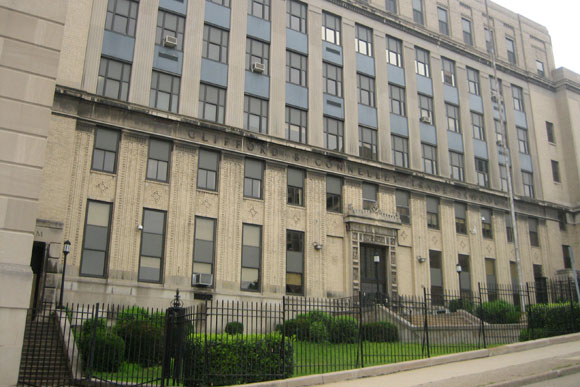
The former Clifford B. Connelley Vocational School will be converted into a green center for sustainable education.
State Senator Jim Ferlo and the board of Pittsburgh Green Innovators hosted tours of the former Clifford B. Connelley Vocational School last Thursday in the Hill District, in order to explain the progress that has taken place in their project to turn the former high school into a green center for sustainable education. The Connelley Project will be a major force in Pittsburgh’s movement towards green workforce development.
The Connelley project is organized by a partnership between Pittsburgh Green Innovators, and the developer Pittsburgh Gateways Incorporated, who are currently leasing the building from the school district. The school district had to shut it down in 2004 due to funding issues.
“The building purchase will be finalized in August, once the school board has finished moving all of its equipment out,” explains Deno de Ciantis, director of the Penn State Center, which plans to be an anchor program in the building.
After the purchase is made, the project will enter phase one of building construction. Both PGI and Green Innovators expect it should be completed by Fall of 2011. They intend to develop approximately 190,000 square feet of the facility’s 230,000 square feet.
“Capital fundraising efforts are on track. Upgrades to the building will include deep energy retrofits, the purchase of energy production equipment, and costs associated with LEED certification,” says Senator Ferlo.
Although a wide number of organizations have expressed interest in securing space at the building, de Ciantis says that leasing on spaces will not begin until after the purchase has been made. What de Ciantis and Ferlo are certain about, however, is that using the Connelley building to educate and train students and adults with the skills they need to excel in green job fields is critical to the growth of the green economy in Pittsburgh.
Writer: John Farley
Sources: Deno de Ciantis, Director of the Penn Center
Senator Jim FerloPhotograph Copyright John Farley


